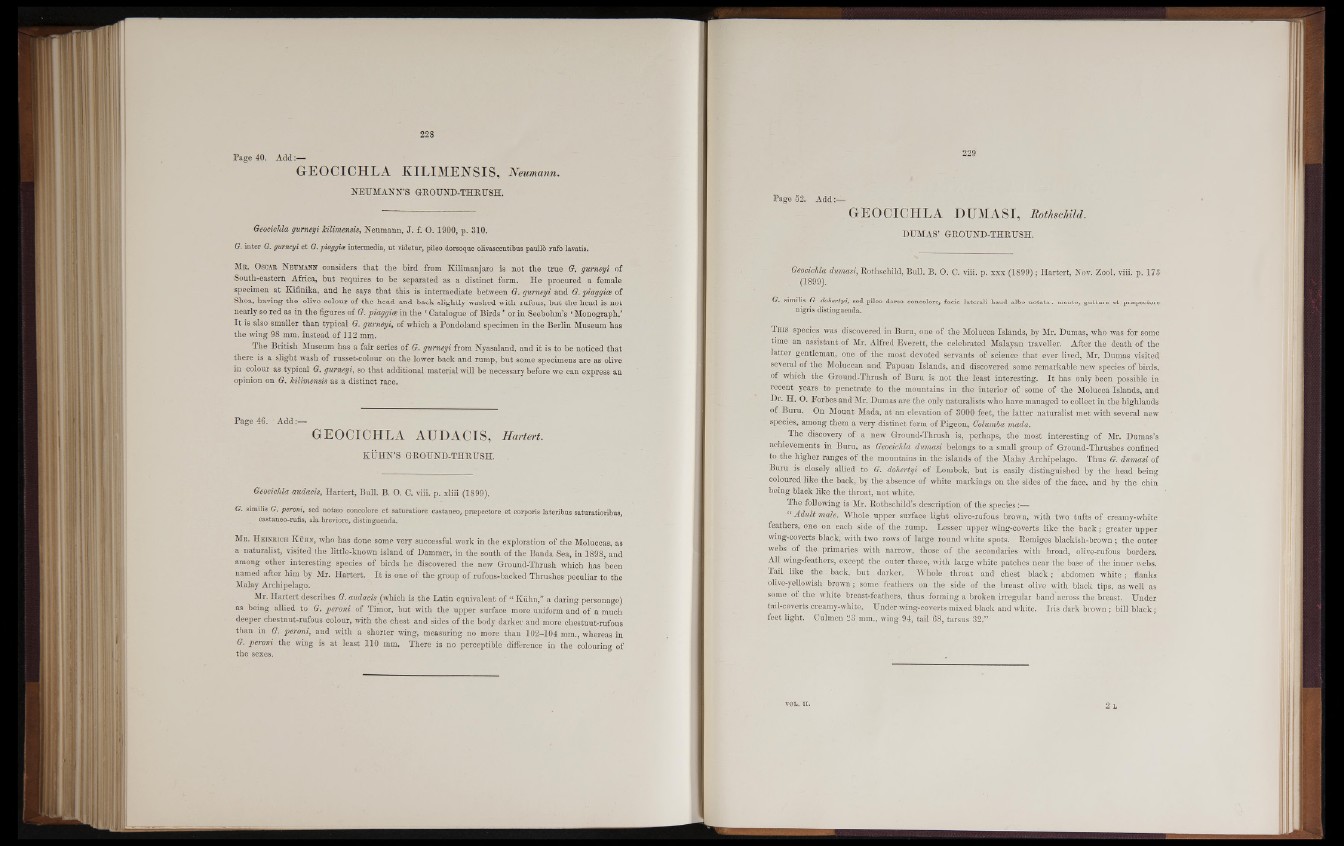
Page 40. Add:—
GEOC ICHLA KILIMENS IS , Neumann.
NEUMANN’S GROUND-THRUSH.
Geocichla gumeyi Jcilimensis, Neumann, J . f. O. 1900, p. 310.
G. inter G. gumeyi et G. piaggice intermedia, u t videtur, pileo dorsoque olivas centibus paullo rufo la vat is.
Mr . Oscar N eumann considers tbat the bird from Kilimanjaro is not the true G. gumeyi of
South-eastern Africa, but requires to be separated as a distinct form. He procured a female
specimen at Kifinika, and he says that this is intermediate between G. gumeyi and G. piaggice of
Shoa, having the olive colour of the head and back slightly washed with rufous, but the head is not
nearly so red as in the figures of G. piaggice in the * Catalogue of Birds ’ or in Seebohm’s ‘ Monograph.’
I t is also smaller than typical G. gumeyi, of which a Pondoland specimen in the Berlin Museum has
the wing 98 mm. instead of 112 mm.
The British Museum has a fair series of G. gumeyi from Nyasaland, and it is to be noticed that
there is a slight wash of russet-colour on the lower back and rump, but some specimens are as olive
in colour as typical G. gumeyi, so that additional material will be necessary before we can express an
opinion on G. kilimensis as a distinct race.
Page 46. Add:—
GEOCICHLA A U D A C I S , Hartert.
KUHN’S GROUND-THRUSH. .
Geocichla audacis, Hartert, Bull. B. O. C. -mi. p. xliii (1899).
G. aimilis G. peroni, sed notseo eoneolore et saturatiore castaneo, pnepectore et corporis lateribus saturatioribus,
castaneo-rufis, ala-breviore, distinguenda.
M r. H einrich K uhn, who has done some very successful work in the exploration of the Moluccas, as
a naturalist, visited the little-known island of Dammer, in the south of the Banda Sea, in 1898, and
among other interesting species of birds he discovered the new Ground-Thrush which has been
named after him by Mr. Hartert. I t is one of the group of rufous-backed Thrushes peculiar to the
Malay Archipelago.
Mr. Hartert describes G. audacis (which is the Latin equivalent of “ Kuhn,” a daring personage)
as being allied to G. peroni of Timor, but with the upper surface more uniform and of a much
deeper chestnut-rufous colour, with the chest and sides of the body darker and more chestnut-rufous
than in G. peroni, and with a shorter wing, measuring no more than 102-104 mm., whereas in
G. peroni the wing is at least 110 mm. There is no perceptible difference in the colouring of
the sexes.
Page 52. Add
GEOCICHLA DUMAS I , Rothschild.
DUMAS’ GBOUND-THRUSH.
Geocichla dumasi, Rothschild, Bull. B. O. C. viii. p. xxx (1899); Hartert, Nov. Zool. viii. p. 173
(1899).
G. similis G. dohertyi, sed pileo dorso eoneolore, facie laterali haud albo n o ta ta : mento, gutture et praepectore
nigris distinguenda.
This species, was discovered in Buru, one of the Molucca Islands, Jby Mr. Dumas, who was for some
time an assistant of Mr. Alfred Everett, the celebrated Malayan traveller. After the death of the
latter gentleman, one of the most devoted servants of science that ever lived, Mr. Dumas visited
several of the Moluccan and Papuan Islands, and discovered some remarkable new species of birds,
of which the Ground-Thrush of Buru is not the least interesting. I t has only been possible in
recent years to penetrate to the mountains in the interior of some of the Molucca Islands, and
Dr. H. O. Forbes and Mr. Dumas are the only naturalists who have managed to collect in the highlands
of Buru. On Mount Mada, at an elevation of 3000 feet, the latter naturalist met with several new
species, among them a very distinct form of Pigeon, Columba mada.
The discovery of a new Ground-Thrush is, perhaps, the most interesting of Mr. Dumas’s
achievements in Buru, as Geocichla dumasi belongs to a small group of Ground-Thrushes confined
to the higher ranges of the mountains in the islands of the Malay Archipelago. Thus G. dumasi of
Buru is closely allied to G. dohertyi of Lombok, but is easily distinguished by the head being
coloured like the back, by the absence of white markings on the sides of the face, and by the chin
being black like the throat, not white.
The following is Mr. Rothschild’s description of the species:—-
“ Adult male. Whole upper surface light olive-rufous brown, with two tufts of creamy-white
feathers, one on each side of the rump. Lesser upper wing-coverts like the back; greater upper
wing-coverts black, with two rows of large round white spots. Remiges blackish-brown ; the outer
webs of the. primaries with narrow, those of the secondaries with broad, olive-rufous borders.
All wing-feathers, except the outer three, with large white patches near the base of the inner webs,
la il like the back, but darker. Whole throat and chest black; abdomen white; flanks
olive-yellowish brown; some feathers on the side of the breast olive with black tips, as well as
some of the white breast-feathers, thus forming a broken irregular band across the breast. Under
fctil-coverts creamy-white. Under wing-coverts mixed black and white. Iris dark brown; bill black;
feet light. Culmen 23 mm., wing 94, tail 68, tarsus 32.”